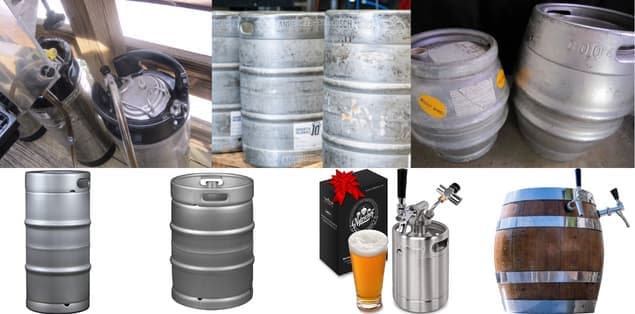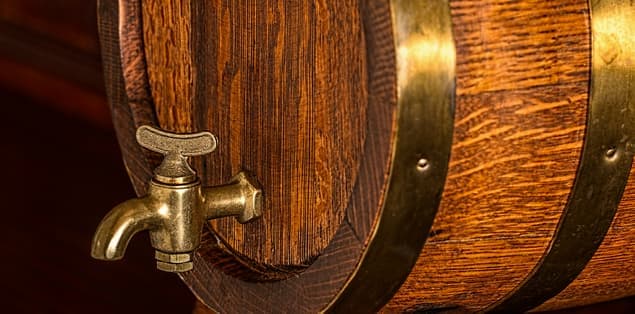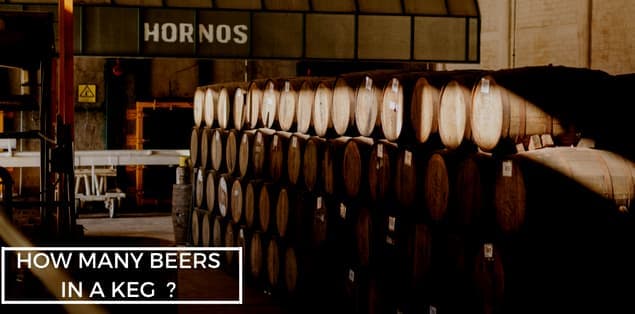So, how many beers in a keg? There is a vast beer universe out there, and all of us are just inhabitants of that universe. So suppose you have settled on installing a kegerator in your area. In that case, you are probably thinking about the numerous alternatives available. So it would be best to educate yourself on the various keg sizes of draft beer that are now available on the market to make the most of your selection.
Are you curious about the number of beers contained in a keg? Or maybe you are interested in knowing how much a full keg weighs.
So, without any further ado, let’s jump right into it!
How Many Beers Are in a Keg?

Below is the complete information for different kegs and their beer capacities.
Cornelius Keg
Corny Keg, Homebrew Keg, and Soda Keg are some of the more common nicknames for this product.
In its original form, the Cornelius Keg (or Corny Keg), a stainless steel cannister, was used to preserve, transport, and distribute sodas such as Pepsi and Coke.
Corny Kegs hold five gallons of beer and are simple to fill, clean, and maintain. Hence, they have become increasingly popular with homebrewers who prefer to avoid the bottling procedure and drink their beer straight from the keg.
However, some earlier versions of Cornelius Kegs still retain a pin-lock connection mechanism.
- It can contain about 40 pints of beer per keg and 53 cans/bottles per keg.
Sixth Barrel Keg
Alternatively known as Sixtel, 1/6 Barrel, or 1/6 BBL
There are many similarities between a Cornelius Keg and a regular Sixth Barrel Keg (16 Barrel), except that the Sixth Barrel Keg is somewhat larger. Dispensing beer from a typical keg valve needs a keg coupler rather than the ball or pin-lock connection systems used by other styles.
Many craft brewers only sell their small-batch experiments in kegs of this size, which has increased the popularity of 16 Barrels (also known as sixtels). Because Sixth Barrel Kegs take up less room than their larger brethren, many beer-minded restaurateurs that want to offer their clients a broad choice of beers will choose these brews.
Because a regular kegerator cabinet can hold two of these Sixth Barrel Kegs, having a dual-tap kegerator in your house is feasible.
- It can contain about 41 pints of beer per keg and 55 cans/bottles per keg.
Quarter Barrel Keg
Pony Keg, Stubby Quarter, and 1/4 BBL are some of its other names.
The “slender” characteristic of the Quarter Barrel keg gives it an appearance similar to that of the standard beer keg you are used to witnessing at keg parties. In this size, it’s ideal for small gatherings.
- It can contain about 62 pints of beer per keg and 82 cans/bottles per keg.
Slim Quarter Keg
Tall Quarter and Slim 1/4 BBL are some other names for it.
You may store the same volume in this tall, thin keg in its shorter and stubbier sibling, the Quarter Barrel Keg. The size of this keg may be advantageous for dual-tap kegerators; nevertheless, it has a capacity of 7.75 gallons, which is over two gallons higher than that of a sixtel keg.
- It can contain about 62 pints of beer per keg and 82 cans/bottles per keg.
Half Barrel Keg
Full-Size Keg, Full Keg, and 1/2 BBL are some other names for this kind of keg.
What comes to mind when you think of the classic beer keg? The fact that it is likely the 15.5 gallons Half Barrel Keg is the largest of them all! If you’re reading this, chances are you’ve sipped a red Solo cup from either of these gems while enjoying a macro brew.
Most pubs and restaurants also use this kind of keg, which will accommodate any standard-sized kegerator. The smaller bottles are best if you’re looking to branch out and explore different beers.
- It can contain about 124 pints of beer per keg and 165 cans/bottles per keg.
50 Liter Keg
Import Keg, and European Barrel, are variations of the 50-liter keg.
An American Half Barrel Keg is a 50-liter keg, which European breweries also use. Europe, especially the United Kingdom, uses this keg size. Heineken, Newcastle, Hoegaarden, and Stella Artois are well-known imports in the United States.
Remember that US Sankey D couplers are not compatible with import kegs. For assistance locating the proper coupler, see a keg coupler guide or contact your keg’s manufacturer.
- It can contain about 105 pints of beer per keg and 140 cans/bottles per keg.
Mini Keg
A Mini Keg is a great alternative to bringing a 12-pack to a small group of close friends because of its barrel-like form. This keg includes about 14 12-ounce portions inside the 5-liter mini keg.
Heineken micro kegs, which feature a CO2 canister to distribute the beer, are the most widely used and easiest to come by. Based on where you’re from, you may be able to get certain extra imports and some craft brews in the form of tiny kegs. When utilizing these small kegs, first, you open the plug at the mouth of the keg to let air in, and then you use the spigot at the bottom to pour the beer out.
- It can contain about 10.6 pints of beer per keg and 14 cans/bottles per keg.
How Many Beers Are in Half a Keg?
A half keg, often referred to as a half-barrel keg, contains the equivalent of 165 12-ounce bottles or cans or 124 16-ounce pints.
How Many Beers Are in a 1/6 Keg?
The quantity of beer that a 1/6 keg may contain is equivalent to either 55 12-ounce cans or bottles or 41 16-ounce pints.
How Many Beers Are in a 1/4 Keg?
The quantity of beer that a 1/4 keg may contain is equal to 62 pints of 16 ounces each or 82 cans or bottles of 12 ounces each.
How Many Ounces in a Keg of Beer?
Different kegs have different capacities in ounces, but in general, the half-barrel keg’s biggest keg has 640 ounces of beer in it.
How Many Gallons in a Keg of Beer?
Different kegs have different capacities in gallons, but in general, the half-barrel keg’s biggest keg has 15.5 gallons of beer.
How Many Kegs Do I Need for 120 Guests?

We should, as a general rule of thumb, plan on purchasing one keg for every one hundred persons. But, of course, they will always have one “in reserve,” regardless of the amount we provide them with. So the strategy calls for 1.5 kegs to be available for the 120 guests.
Suppose visitors plan to consume one drink each hour during the party’s duration of five hours. In that case, the host will need to provide around 750 beverages. If beer is the sole beverage offered at your gathering, you will need around 30 24-packs of beer or six kegs of beer.
Is a Keg Cheaper Than Cans?
When buying beer in a keg or a can is more cost-effective, it is important to consider the specific brand of beer you’re looking to purchase. For example, kegs on their own could be more cost-effective than buying individual beer cans, but you still need to factor in the price of cups.
If you buy a kegerator, you can conveniently store huge amounts of draft beer. So, for example, suppose you compare the cost of kegerators to that of cans or bottles of beer. In that case, you will see that you can save anywhere from 40 to 60 percent of the original price.
Final Words – How Many Beers in a Keg?
Kegs are an essential component of the business operations of almost every bar, but keeping track of their inventory may be difficult due to the complexity of the kegs. There are more kegs than what we discussed in this article, such as a ball lock corny keg, and ball lock kegs, pin lock kegs. We hope that both the knowledge and the activity help you become more efficient in managing your liquor inventory.
It is often useful to know how many beers a keg of beer includes to make the inventory management process go more smoothly. In addition, maintaining a steady inventory is essential to supplying a bar profitably.
Utilizing a permanent inventory bar system like BinWise Pro is another approach you can take to improve the efficiency of your inventory procedure. It transforms the time-consuming task of manually counting inventory into a rapid sequence of scans, saving both time and effort.
Additionally, it helps prevent problems such as excessive inventory or finding the answer to the question “does beer freeze?“
